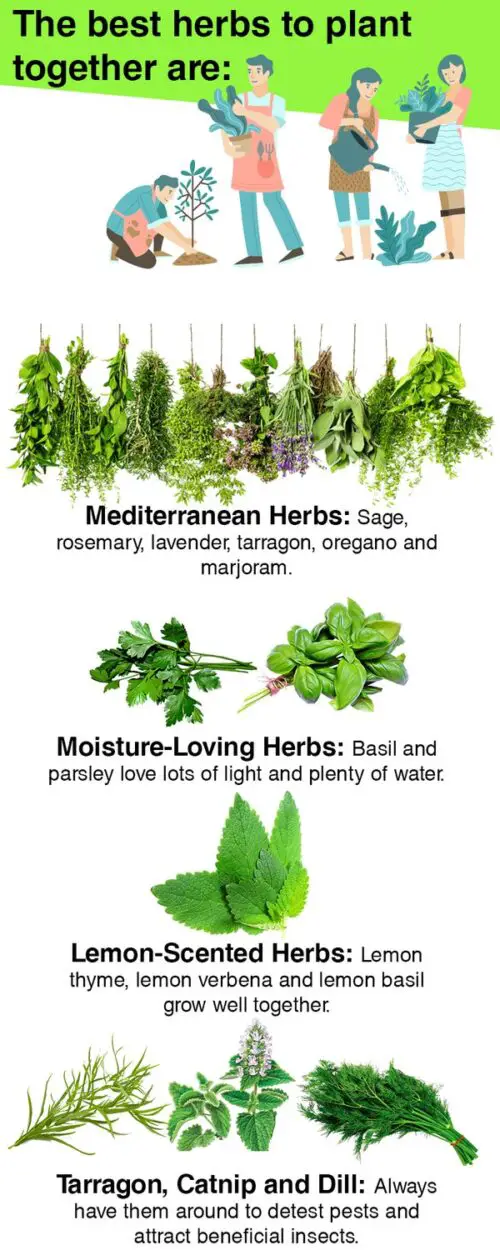Looking to create a harmonious herb garden but unsure which herbs can be planted together? You’ve come to the right place!
In this article, we’ll explore the exciting world of companion planting for herbs. By strategically pairing certain herbs, you can enhance their growth, repel pests, and even improve their flavor.
So, whether you’re a seasoned gardener or just starting, join us as we delve into the fascinating realm of what herbs can you plant together. Get ready to unlock the secrets of successful herb combinations and take your gardening skills to new heights!
What Herbs Can You Plant Together?
When it comes to herb gardening, choosing the right combination of herbs to plant together can have a significant impact on the overall health and growth of your herbs.
Certain herbs thrive when planted together, while others may not be compatible due to their differing growth habits, water requirements, or susceptibility to pests and diseases.
In this article, we will explore some popular herb combinations that can be planted together to create a harmonious and flourishing herb garden.
Companion Planting: Benefits and Considerations
Companion planting is a gardening technique that involves planting different plants in close proximity to enhance growth, deter pests, and promote overall plant health. When it comes to herbs, companion planting can be especially beneficial. Here are a few reasons why:
- Pest control
Some herbs, when planted together, can help repel pests naturally. For example, planting dill alongside cabbage can deter cabbage worms, while planting basil near tomatoes can help repel tomato hornworms.
- Improved flavor
Certain herb combinations can enhance the flavor of neighboring plants. For instance, planting rosemary near carrots can impart a savory flavor to the carrots.
- Space optimization
Planting compatible herbs together allows you to make the most of limited garden space, as they can share resources without competing excessively.
While companion planting offers many benefits, it’s essential to consider a few factors before deciding which herbs to plant together:
- Growth habits
Some herbs tend to spread vigorously, while others have a more compact growth habit. Be mindful of the space requirements of each herb to avoid overcrowding.
- Water and sunlight needs
Different herbs have varying requirements for water and sunlight. Plant those with similar needs together to ensure proper care and prevent under- or over-watering.
- Soil preferences
Consider the soil pH and nutrient requirements of each herb. Planting herbs with similar soil preferences together can help ensure optimal growth.
Complementary Herb Combos
- Basil, parsley, and chives:
– Basil enhances the flavor of tomatoes and repels pests like aphids, making it an excellent companion for tomatoes.
– Parsley improves the flavor of many dishes and attracts beneficial insects.
– Chives deter pests like aphids and carrot flies when planted near carrots.
- Rosemary, thyme, and sage:
– Rosemary and sage are both drought-tolerant herbs that require well-draining soil. They complement each other’s flavors and are often used together in culinary recipes.
– Thyme is a low-growing herb that spreads easily. Planting it with rosemary and sage provides ground cover and helps deter some pests.
- Oregano, marjoram, and tarragon:
– Oregano and marjoram are closely related herbs with similar flavors. Planting them together allows for easy harvesting and maximizes their pest-repelling properties.
– Tarragon complements the flavors of both oregano and marjoram and attracts pollinators like bees and butterflies.
- Mint, lemon balm, and chamomile:
– Mint and lemon balm are both fast-growing herbs that can become invasive. Planting them together in containers or confined spaces prevents them from overpowering the garden.
– Chamomile attracts beneficial insects and adds a calming aroma to the garden.
Herbs That Should Be Planted Alone
While companion planting is beneficial for most herbs, some herbs prefer to be planted alone due to various reasons. Here are a few examples:
- Dill
Dill is known to inhibit the growth of some plants, such as carrots and tomatoes. It is best planted away from other herbs or vegetables.
- Fennel
Fennel has a sprawling growth habit and can inhibit the growth of other plants. It is recommended to plant fennel in a separate area.
- Coriander (Cilantro)
Coriander can bolt and go to seed quickly, resulting in reduced growth for neighboring herbs. It is preferable to plant coriander separately.
Tips for Successful Herb Combinations
To ensure successful herb combinations in your garden, keep the following tips in mind:
1. Plan ahead: Before planting, research the growth habits, water requirements, and compatibility of different herbs. This will help you design a well-organized and thriving herb garden.
2. Consider container gardening: If you have limited space or want more control over the growth of your herbs, consider planting them in containers. This allows you to create specific combinations and easily move herbs as needed.
3. Rotate herbs: To avoid depleting soil nutrients and minimize the risk of diseases, rotate your herbs annually. This means planting them in different areas of the garden each year.
4. Regular maintenance: Regularly prune and harvest your herbs to maintain their shape, encourage bushier growth, and prevent overcrowding. This promotes air circulation and reduces the risk of disease.
5. Observe and adjust: Keep an eye on your herb garden and make adjustments as needed. If you notice any issues like pests or diseases, take appropriate measures to address them promptly.
In conclusion, choosing the right combination of herbs to plant together can have a significant impact on the overall health and productivity of your herb garden. By practicing companion planting and considering factors such as growth habits, water requirements, and soil preferences, you can create a thriving and harmonious herb garden. Experiment with different combinations, and don’t be afraid to adjust your planting arrangements based on observation and experience. Happy herb gardening!
Frequently Asked Questions (FAQs)
When planning an herb garden, it’s important to consider which herbs can be planted together to ensure optimal growth and compatibility.
Yes, rosemary and thyme can be planted together as they both prefer well-drained soil and similar growing conditions.
While basil and parsley have different moisture requirements, they can still be planted together. Ensure the soil is well-drained and water accordingly.
No, it is not recommended to plant mint and chives together as mint tends to be invasive and can overtake other plants in the same container.
Yes, cilantro and dill can be planted together as they have similar growing requirements. Both herbs prefer full sun and well-drained soil.
Absolutely! Sage and oregano are great companion plants and can be planted side by side. They both prefer full sun and well-drained soil.
Yes, lavender and thyme make excellent companions and can be planted together. They both thrive in well-drained soil and require similar growing conditions.
Yes, chamomile and lemon balm can be planted in the same area as they have compatible growing requirements. They both prefer moist soil and partial shade.
Yes, cilantro and tarragon can be planted together in a raised bed. They both prefer well-drained soil and partial shade.
Final Thoughts
What herbs can you plant together? There are several combinations of herbs that can thrive together and complement each other’s growth. For example, planting basil, parsley, and cilantro in close proximity not only enhances their flavors but also helps deter pests.
Similarly, pairing rosemary, thyme, and sage creates a harmonious aromatic blend. Additionally, planting chamomile and lavender side by side promotes a calming and soothing atmosphere in your garden. By strategically choosing and planting herbs together, you can optimize space, encourage healthy growth, and create a vibrant and diverse herb garden.
Auto Amazon Links: No products found.
Perfect Plants Christmas Tree Saver 8oz. | Easy Use Xmas Tree Preserver Food | Have Healthy Green Christmas Trees All Holiday Season
$7.99 (as of December 24, 2025 06:36 GMT +00:00 - More info- Product prices and availability are accurate as of the date/time indicated and are subject to change. Any price and availability information displayed on [relevant Amazon Site(s), as applicable] at the time of purchase will apply to the purchase of this product.
FirEver Pure Christmas Tree Food | Preserver Additive & Season Extender for Live Xmas Trees | Keep It Green, Reduce Needle-Drop | Miracle Freshness (8 oz)
$9.16 (as of December 24, 2025 06:36 GMT +00:00 - More info- Product prices and availability are accurate as of the date/time indicated and are subject to change. Any price and availability information displayed on [relevant Amazon Site(s), as applicable] at the time of purchase will apply to the purchase of this product.
Wilt-Pruf® Christmas Tree/Cutting Preserver Spray |Preserves Christmas Trees, Wreaths, Garlands, Cuttings and Carved Pumpkins | Reduces Needle Drop | Keeps Cut Trees Fresh Longer | Natural (32 oz)
$21.99 (as of December 24, 2025 06:36 GMT +00:00 - More info- Product prices and availability are accurate as of the date/time indicated and are subject to change. Any price and availability information displayed on [relevant Amazon Site(s), as applicable] at the time of purchase will apply to the purchase of this product.
Transmission Funnel - 3'' Wide 23'' Long Funnel with Hose – Flexible, Reusable, No Leak Design Featuring Elastic Long Hose | Long Funnel for Oil, Gas, Coolant, Automotive and Garage Applications
$7.95 (as of December 24, 2025 06:36 GMT +00:00 - More info- Product prices and availability are accurate as of the date/time indicated and are subject to change. Any price and availability information displayed on [relevant Amazon Site(s), as applicable] at the time of purchase will apply to the purchase of this product.
TreeVive™ Natural Christmas Tree Preservative – Extends Freshness & Needle Retention – Enhances Pine Scent – Safe, Non-Toxic, Pet-Friendly Additive for Hydration, Color & Holiday Tree Care
$8.99 (as of December 24, 2025 06:36 GMT +00:00 - More info- Product prices and availability are accurate as of the date/time indicated and are subject to change. Any price and availability information displayed on [relevant Amazon Site(s), as applicable] at the time of purchase will apply to the purchase of this product.
Muddy Mat® | Super Absorbent Door Mat Indoor, Microfiber Quick Dry Chenille Entryway Rug, Non-Slip Front Door Mat, Indoor Mats for Entryway, Machine Washable Pet Rug, Grey 30"x19"
$19.95 (as of December 24, 2025 12:36 GMT +00:00 - More info- Product prices and availability are accurate as of the date/time indicated and are subject to change. Any price and availability information displayed on [relevant Amazon Site(s), as applicable] at the time of purchase will apply to the purchase of this product.
OLANLY Dog Door Mat for Muddy Paws 30x20, Absorbs Moisture and Dirt, Absorbent Non-Slip Washable Doormat, Quick Dry Chenille Mud Mat for Dogs, Entry Indoor Entryway Carpet for Inside Floor, Grey
$9.99 (as of December 24, 2025 12:36 GMT +00:00 - More info- Product prices and availability are accurate as of the date/time indicated and are subject to change. Any price and availability information displayed on [relevant Amazon Site(s), as applicable] at the time of purchase will apply to the purchase of this product.
Zevo Flying Insect Trap Official Refill Cartridges - Fits Both Zevo Trap & MAX Indoor Fly Trap - Authentic Trap+Lock Technology to Catch Gnats, House & Fruit Flys (4 Official Refill Cartridges)
$14.97 (as of December 24, 2025 12:36 GMT +00:00 - More info- Product prices and availability are accurate as of the date/time indicated and are subject to change. Any price and availability information displayed on [relevant Amazon Site(s), as applicable] at the time of purchase will apply to the purchase of this product.
TERRO Ant Killer Bait Stations T300B - Liquid Bait to Eliminate Ants - Bait System - 12 Count Stations for Effective Indoor Ant Control
$10.88 (as of December 24, 2025 12:36 GMT +00:00 - More info- Product prices and availability are accurate as of the date/time indicated and are subject to change. Any price and availability information displayed on [relevant Amazon Site(s), as applicable] at the time of purchase will apply to the purchase of this product.
ThermoPro TP50 Digital Hygrometer Indoor Thermometer Room Thermometer and Humidity Gauge with Temperature Humidity Monitor
$11.99 (as of December 24, 2025 12:36 GMT +00:00 - More info- Product prices and availability are accurate as of the date/time indicated and are subject to change. Any price and availability information displayed on [relevant Amazon Site(s), as applicable] at the time of purchase will apply to the purchase of this product.











